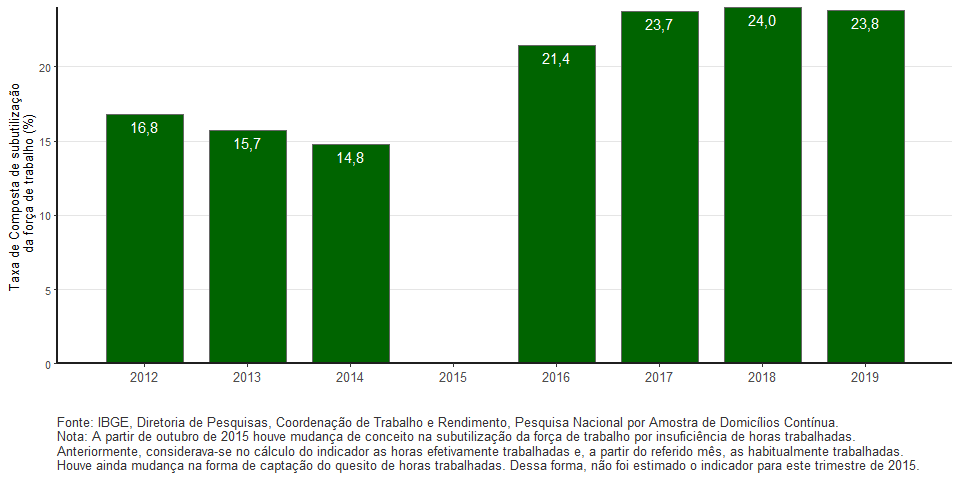Continuous PNAD: unemployment rate is 11.6% and underutilization rate is 23.8% in quarter ending in October 2019
November 29, 2019 09h00 AM | Last Updated: November 29, 2019 05h19 PM
The unemployment rate (11.6%) remained statistically stable in the moving quarter ended in October 2019 both in relation to the quarter from May to July 2019 (11.8%) and in relation to the same quarter of 2018 (11.7%).
| Indicator / Period | Aug-Sep-Oct 2019 | May-Jun-Jul 2019 | Aug-Sep-Oct 2018 |
|---|---|---|---|
| Unemployment rate | 11.6% | 11.8% | 11.7% |
| Underutilization rate | 23.8% | 24.6% | 24.0% |
| Usual real earnings | R$2,317 | R$2,292 | R$2,298 |
| Change of the usual real earnings in relation to: | 1.1% (stable) | 0.8% (stable) | |
The unemployed population (12.4 million persons) remained statistically stable in both comparisons.
The employed population (94.1 million) increased in both comparisons: 0.5% compared with the previous quarter (more 470 thousand persons) and 1.6% (more 1.4 million persons) in relation to the same quarter of 2018.
The population out of the workforce (64.9 million persons) remained stable in both comparisons.
The compound underutilization rate of the workforce (23.8%) changed -0.8 p.p. in relation to the previous moving quarter (24.6%) and remained statistically stable in relation to the same moving quarter of 2018 (24.0%).
The underutilized population (27.1 million persons) retreated (-3.5% or less 972 thousand persons) against the previous moving quarter and remained statistically stable in relation to the same quarter of 2018 (27.1 million persons).
The discouraged population (4.6 million) declined (-4.5% or less 217 thousand persons) in relation to the previous moving quarter and remained stable against the same quarter of 2018 (4.7 million). The percentage of discouraged in relation to the population in the workforce or discouraged (4.2%) changed -0.2 p.p. over the previous quarter (4.4%) and remained statistically stable against the same quarter of 2018 (4.3%).
The number of employed persons with a formal contract in the private sector – excluding domestic workers – reached 33.2 million, remaining stable in both comparisons. The category of those employed without a formal contract in the private sector (11.9 million persons) was a new record in the time series, remaining statistically stable in relation to the previous moving quarter and rising 2.4% (more 280 thousand persons) against the same quarter of 2018.
The category of the self-employed workers reached 24.4 million persons, a new record in the time series, remaining stable against the previous quarter and rising 3.9% (more 913 thousand persons) in relation to the same period of 2018.
The average usual real earnings (R$2,317) in the quarter ended in October 2019 remained stable in both comparisons. The usual real wage bill(R$212.8 billion) increased in both comparisons: 1.8% against the previous moving quarter and 2.6% against the same period of 2018.
Unemployment Rate - Brazil - 2012/2019
The employment-population ratio – percentage of employed persons at working age – was estimated at 54.9%, remaining stable in relation to the quarter between May and July 2019 (54.7%) and changing 0.4 p.p. in relation to the same quarter of 2018 (54.5%).
Estimated at 106.4 million persons, the workforce – employed and unemployed persons – remained stable in relation to the previous moving quarter and grew 1.4% (more 1.5 million persons) against the same quarter of 2018.
The potential workforce (7.8 million persons) dropped (-5.3% or less 438 thousand persons) in relation to the previous quarter and remained stable against the same quarter of 2018.
The contingent out of the workforce in the quarter from August to October 2019 was estimated at 64.9 million persons and remained stable in both comparisons.
Compound underutilization rate – quarters from August to October – 2012/2019 Brazil (%)
The number of time-related underemployed persons(7.0 million) retreated (-4.5% or less 332 thousand persons) against the previous moving quarter and remained stable against the same quarter of 2018.
The categories of the employers (4.5 million persons) and domestic workers (6.3 million persons) remained stable in both comparisons.
Estimated at 11.7 million persons, those employed in the public sector – including statutory servants and military – remained statistically stable in both comparisons.
In relation to the previous moving quarter, employment rose in the group of Construction (3.0% or more 197 thousand persons) and retreated in Agriculture, livestock, forestry, fishing and aquaculture (-2.3% or less 199 thousand persons). The other groups did not show any significant changes.
In relation to the same moving quarter of 2018, employment increased in three activity groups: Transportation, storage and mailing (5.0% or more 233 thousand persons), Information, communication and financial, real estate, professional and administrative activities (3.2% or more 324 thousand persons) and Housing and food (3.9% or more 206 thousand persons). The other groups did not show any significant changes.
Except for Other services, which rose 4.6% in relation to the immediately previous moving quarter, the usual real average earnings in the main job of all the activity groups remained stable in both comparisons.
Average monthly real earnings, usually earned in the reference month,
from all jobs of employed persons - Brazil - 2012/2019 - (R$)

